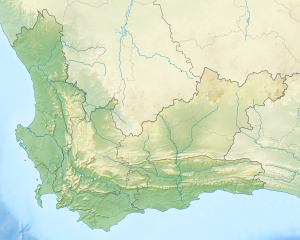
Fynbos is a small belt of natural shrubland or heathland vegetation located in the Western Cape and Eastern Cape provinces of South Africa. This area is predominantly coastal and mountainous, with a Mediterranean climate and rainy winters. The fynbos ecoregion is within the Mediterranean forests, woodlands, and scrub biome. In fields related to biogeography, fynbos is known for its exceptional degree of biodiversity and endemism, consisting of about 80% species of the Cape floral kingdom, where nearly 6,000 of them are endemic. This land continues to face severe human-caused threats, but due to the many economic uses of the fynbos, conservation efforts are being made to help restore it.

The Cape Floral Region is a floristic region located near the southern tip of South Africa. It is the only floristic region of the Cape Floristic Kingdom, and includes only one floristic province, known as the Cape Floristic Province.

Helderberg refers to a planning district of the City of Cape Town metropolitan municipality, the mountain after which it is named, a wine-producing area in the Western Cape province of South Africa, or a small census area in Somerset West.

The Kogelberg is a range of mountains along the False Bay coast in the Western Cape of South Africa. They form part of the Cape Fold Belt, starting south of the Elgin valley and forming a steep coastal range as far as Kleinmond.

Orothamnus or marsh rose is a monotypic fynbos genus in the family Proteaceae occurring in the Kogelberg and Kleinrivier Mountains of Hottentots-Holland in the Western Cape Province of South Africa. It is an erect, sparsely branched shrub to 5 m tall and was first depicted by Jean Villet, a Capetonian artist and dealer in natural history specimens, in Curtis's Botanical Magazine 74: plate 4357 in 1848.

Newlands Forest is a conservancy area on the eastern slopes of Table Mountain, beside the suburb of Newlands, Cape Town, South Africa. It is owned and maintained by the Table Mountain National Parks Board, along with the City Parks Department of Cape Town, and includes a Fire Station, Nursery and Reservoir.

Leucospermum conocarpodendron is the largest species of the genus Leucospermum, reaching almost tree-like proportions of 5–6 m (16–20 ft) high with a firm trunk that is covered in a thick layer of cork that protects it from most fires. It has greyish or green narrow or broad inverted egg-shaped leaves with three to ten teeth near the tip and large yellow flowerheads, with firm, bent, yellow styles that stick far beyond the rest of the flower and give the impression of a pincushion. It is commonly known as the tree pincushion in English or goudsboom in Afrikaans. They naturally occur near Cape Town, South Africa.
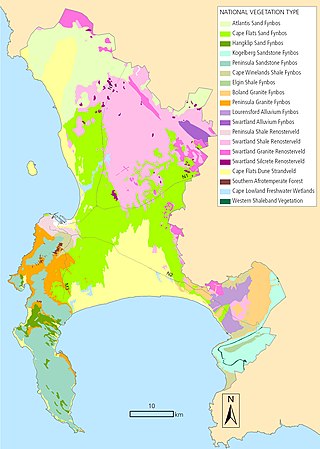
The Biodiversity of Cape Town is the variety and variability of life within the geographical extent of the City of Cape Town metropolitan municipality, excluding the Prince Edward Islands. The terrestrial vegetation is particularly diverse and much of it is endemic to the city and its vicinity. Terrestrial and freshwater animal life is heavily impacted by urban development and habitat degradation. Marine life of the waters immediately adjacent to the city along the Cape Peninsula and in False Bay is also diverse, and while also impacted by human activity, the habitats are relatively intact.

Lourensford Alluvium Fynbos is a critically endangered vegetation type that is endemic to Cape Town. Though closest to Fynbos, it has characteristics of both Fynbos and Renosterveld vegetation and is thus actually a unique hybrid vegetation type.

Kogelberg Sandstone Fynbos is a critically endangered vegetation type occurring in the far south of the Western Cape, South Africa.
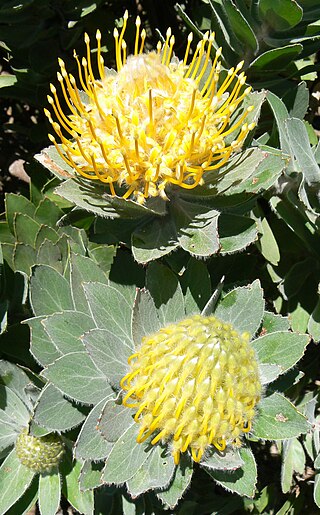
Peninsula Granite Fynbos is an endangered Fynbos vegetation type which is endemic to the city of Cape Town and occurs nowhere else. It is a unique type of tall, dense and diverse scrubland, scattered with trees. It can be found all along the belt of granite that encircles Table Mountain.

Peninsula Sandstone Fynbos is a unique and endangered vegetation type that is endemic to the Cape Peninsula in Cape Town. This type of Mountain Fynbos occurs on very poor, acidic soils but is incredibly rich in biodiversity with an enormous number of plant species – many of which occur nowhere else. Due to its poor soils and steep, inaccessible location, it has not been developed for farming or houses, and consequently it is relatively well conserved.

Cape Winelands Shale Fynbos is a vegetation type that naturally occurs in the Cape Winelands of the Western Cape, South Africa.

De Hel Nature Area is a 21.3-hectare (53-acre) nature reserve protecting a river valley and indigenous forest on the lower eastern slopes of Table Mountain, Cape Town, South Africa.

Durbanville Nature Reserve is a 6-hectare (15-acre) piece of protected land, located next to the Hollywoodbets Durbanville Racecourse in the Western Cape, South Africa.

Silwerboomkloof Natural Heritage Site is a small, protected valley (“kloof”), near the Helderberg Nature Reserve, in Somerset West, South Africa.

Kogelberg Nature Reserve is a nature reserve of 3,000 ha comprising the Kogelberg Mountain Range, to the east of Cape Town, South Africa.

Cecilia is a section of the Table Mountain National Park on the lower eastern slopes of Table Mountain in Cape Town, located just to the south of Kirstenbosch National Botanical Garden. It was previously used for commercial logging and known as Cecilia Forest or Cecilia Plantation, but has now been given protected status and integrated into the National Park.
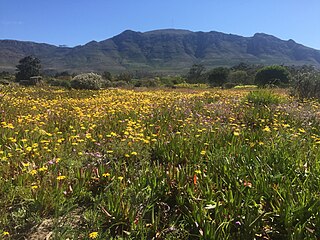
Tokai Park, previously known as "Tokai Forest", is a small wing, about 600 ha, of the greater Table Mountain National Park in Cape Town, South Africa. Tokai Park is made up of two sections: upper and lower Tokai Park. Lower Tokai Park is flat, and characterized by the threatened Cape Flats Sand Fynbos. Upper Tokai Park is on the slopes of Constantiaberg Mountain, and consists of conservation area as well as the Tokai Arboretum. Upper Tokai Park is characterized by Peninsula Granite Fynbos, Peninsula Sandstone Fynbos and Afromontane Forest and noted for its diversity.
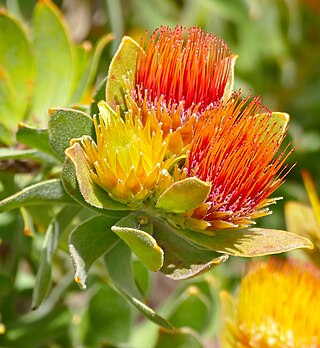
Leucospermum oleifolium is an erect shrub of about 1 m (3.3 ft) high and 1½ m (5 ft) across that is assigned to the family Proteaceae. It has spreading branches, densely set with initially felty, entire, oval, olive-colored leaves of about 3½ cm long and 1½ cm (0.6 in) wide, with a bony tip that sometimes has two to five blunt teeth, with a blunt base and conspicuous veins. The flowers and their long thread-like styles are initially sulfur yellow, but soon become orange and finally turn brilliant crimson. The flower heads are about 4 cm (1.6 in) in diameter, crowded at the tip of the branches with a maximum of five that start flowering in turn. This provides for a colour spectacle from August till December. It is called by various names in South Africa such as Overberg pincushion, flame pincushion, mix pincushion and tuft pincushion. It naturally occurs in fynbos in the Western Cape province of South Africa.


